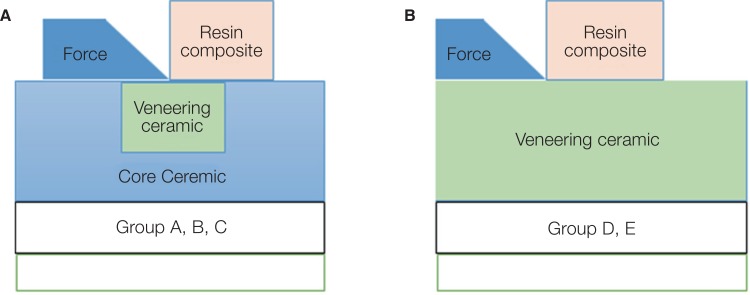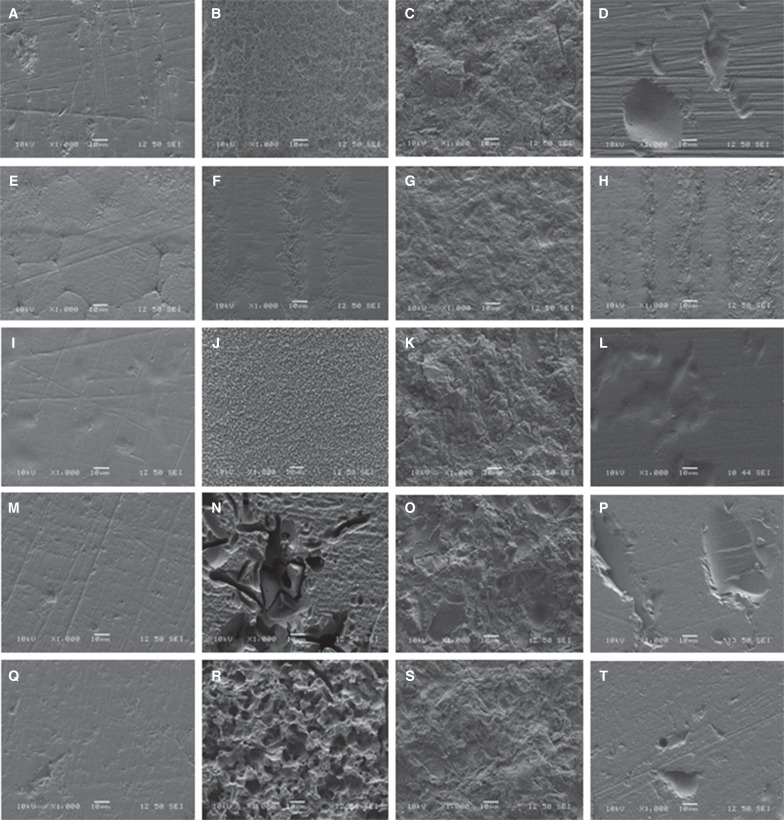J Adv Prosthodont.
2018 Apr;10(2):101-112. 10.4047/jap.2018.10.2.101.
Repair bond strength of resin composite to bilayer dental ceramics
- Affiliations
-
- 1Department of Prosthodontic, Faculty of Dentistry, Mersin University, Mersin, Turkey. sedaataol@gmail.com
- 2Department of Prosthodontics, Faculty of Dentistry, Gazi University, Ankara, Turkey.
- KMID: 2409629
- DOI: http://doi.org/10.4047/jap.2018.10.2.101
Abstract
- PURPOSE
The purpose of this study was to investigate the effect of various surface treatments (ST) on the shear bond strength of resin composite to three bilayer dental ceramics made by CAD/CAM and two veneering ceramics.
MATERIALS AND METHODS
Three different bilayer dental ceramics and two different veneering ceramics were used (Group A: IPS e.max CAD+IPS e.max Ceram; Group B: IPS e.max ZirCAD+IPS e.max Ceram, Group C: Vita Suprinity+Vita VM11; Group D: IPS e.max Ceram; Group E: Vita VM11). All groups were divided into eight subgroups according to the ST. Then, all test specimens were repaired with a nano hybrid resin composite. Half of the test specimens were subjected to thermocycling procedure and the other half was stored in distilled water at 37℃. Shear bond strength tests for all test specimens were carried out with a universal testing machine.
RESULTS
There were statistically significant differences among the tested surface treatments within the all tested fracture types (P < .005). HF etching showed higher bond strength values in Groups A, C, D, and E than the other tested ST. However, bonding durability of all the surface-treated groups were similar after thermocycling (P>.00125).
CONCLUSION
This study revealed that HF etching for glass ceramics and sandblasting for zirconia ceramics were adequate for repair of all ceramic restorations. The effect of ceramic type exposed on the fracture area was not significant on the repair bond strength of resin composites to different ceramic types.
Keyword
Figure
Cited by 1 articles
-
Influence of surface treatments and repair materials on the shear bond strength of CAD/CAM provisional restorations
Ki-Won Jeong, Sung-Hun Kim
J Adv Prosthodont. 2019;11(2):95-104. doi: 10.4047/jap.2019.11.2.95.
Reference
-
1. Hu M, Weiger R, Fischer J. Comparison of two test designs for evaluating the shear bond strength of resin composite cements. Dent Mater. 2016; 32:223–232. PMID: 26723840.
Article2. Sato TP, Anami LC, Melo RM, Valandro LF, Bottino MA. Effects of surface treatments on the bond strength between resin cement and a new zirconia-reinforced lithium silicate ceramic. Oper Dent. 2016; 41:284–292. PMID: 26652019.
Article3. Rinke S, Rödiger M, Ziebolz D, Schmidt AK. Fabrication of zirconia-reinforced lithium silicate ceramic restorations using a complete digital workflow. Case Rep Dent. 2015; 2015:162178. PMID: 26509088.
Article4. Gracis S, Thompson VP, Ferencz JL, Silva NR, Bonfante EA. A new classification system for all-ceramic and ceramic-like restorative materials. Int J Prosthodont. 2015; 28:227–235. PMID: 25965634.
Article5. McLaren EA, Figueira J. Updating classifications of ceramic dental materials: a guide to material selection. Compend Contin Educ Dent. 2015; 36:400–405. PMID: 26053778.6. Vita Suprinity technical and scientific documentation. Retrieved from https://panadent.co.uk/wp-content/uploads/2014/10/Vita-Suprinity-Technical-and-Scientific-Document.pdf.7. Ereifej N, Rodrigues FP, Silikas N, Watts DC. Experimental and FE shear-bonding strength at core/veneer interfaces in bilayered ceramics. Dent Mater. 2011; 27:590–597. PMID: 21477853.
Article8. Zhao K, Pan Y, Guess PC, Zhang XP, Swain MV. Influence of veneer application on fracture behavior of lithium-disilicate-based ceramic crowns. Dent Mater. 2012; 28:653–660. PMID: 22456006.
Article9. Duzyol M, Sagsoz O, Polat Sagsoz N, Akgul N, Yildiz M. The effect of surface treatments on the bond strength between CAD/CAM blocks and composite resin. J Prosthodont. 2016; 25:466–471. PMID: 26216441.
Article10. Guess PC, Zavanelli RA, Silva NR, Bonfante EA, Coelho PG, Thompson VP. Monolithic CAD/CAM lithium disilicate versus veneered Y-TZP crowns: comparison of failure modes and reliability after fatigue. Int J Prosthodont. 2010; 23:434–442. PMID: 20859559.11. Attia A. Influence of surface treatment and cyclic loading on the durability of repaired all-ceramic crowns. J Appl Oral Sci. 2010; 18:194–200. PMID: 20485932.
Article12. Lee SJ, Cheong CW, Wright RF, Chang BM. Bond strength of the porcelain repair system to all-ceramic copings and porcelain. J Prosthodont. 2014; 23:112–116. PMID: 23725343.
Article13. Sailer I, Pjetursson BE, Zwahlen M, Hämmerle CH. A systematic review of the survival and complication rates of all-ceramic and metal-ceramic reconstructions after an observation period of at least 3 years. Part II: Fixed dental prostheses. Clin Oral Implants Res. 2007; 18:86–96.
Article14. Della Bona A, Kelly JR. The clinical success of all-ceramic restorations. J Am Dent Assoc. 2008; 139:8S–13S.15. Akhavan Zanjani V, Ahmadi H, Nateghifard A, Ghasemi A, Torabzadeh H, Abdoh Tabrizi M, Alikhani F, Razi R, Nateghifard A. Effect of different laser surface treatment on microshear bond strength between zirconia ceramic and resin cement. J Investig Clin Dent. 2015; 6:294–300.
Article16. Ozcan M1, Valandro LF, Amaral R, Leite F, Bottino MA. Bond strength durability of a resin composite on a reinforced ceramic using various repair systems. Dent Mater. 2009; 25:1477–1483. PMID: 19671476.17. Kirmali O, Barutcigil Ç, Ozarslan MM, Barutcigil K, Harorlı OT. Repair bond strength of composite resin to sandblasted and laser irradiated Y-TZP ceramic surfaces. Scanning. 2015; 37:186–192. PMID: 25715193.
Article18. Kaygisiz E, Egilmez F, Ergun G, Yuksel S, Cekic-Nagas I. Effect of different surface treatments on bond strength of recycled brackets to feldspathic porcelain. J Adhes Sci Technol. 2016; 30:45–55.
Article19. Blatz MB, Sadan A, Kern M. Resin-ceramic bonding: a review of the literature. J Prosthet Dent. 2003; 89:268–274. PMID: 12644802.
Article20. Kimmich M, Stappert CF. Intraoral treatment of veneering porcelain chipping of fixed dental restorations: a review and clinical application. J Am Dent Assoc. 2013; 144:31–44. PMID: 23283924.21. Diniz AC, Nascimento RM, Souza JC, Henriques BB, Carreiro AF. Fracture and shear bond strength analyses of different dental veneering ceramics to zirconia. Mater Sci Eng C Mater Biol Appl. 2014; 38:79–84. PMID: 24656355.
Article22. Stawarczyk B, Ozcan M, Hämmerle CH, Roos M. The fracture load and failure types of veneered anterior zirconia crowns: an analysis of normal and Weibull distribution of complete and censored data. Dent Mater. 2012; 28:478–487. PMID: 22196897.
Article23. Ozcan M, Valandro LF, Pereira SM, Amaral R, Bottino MA, Pekkan G. Effect of surface conditioning modalities on the repair bond strength of resin composite to the zirconia core / veneering ceramic complex. J Adhes Dent. 2013; 15:207–210. PMID: 23700578.24. Pjetursson BE, Sailer I, Zwahlen M, Hämmerle CH. A systematic review of the survival and complication rates of all-ceramic and metal-ceramic reconstructions after an observation period of at least 3 years. Part I: Single crowns. Clin Oral Implants Res. 2007; 18:73–85. PMID: 17594372.
Article25. Ozcan M, Nijhuis H, Valandro LF. Effect of various surface conditioning methods on the adhesion of dual-cure resin cement with MDP functional monomer to zirconia after thermal aging. Dent Mater J. 2008; 27:99–104. PMID: 18309618.26. Egilmez F, Ergun G, Cekic-Nagas I, Vallittu PK, Ozcan M, Lassila LV. Effect of surface modification on the bond strength between zirconia and resin cement. J Prosthodont. 2013; 22:529–536. PMID: 23551581.
Article27. Amaral R, Ozcan M, Bottino MA, Valandro LF. Microtensile bond strength of a resin cement to glass infiltrated zirconiare-inforced ceramic: the effect of surface conditioning. Dent Mater. 2006; 22:283–290. PMID: 16039705.
Article28. Valandro LF, Della Bona A, Antonio Bottino M, Neisser MP. The effect of ceramic surface treatment on bonding to densely sintered alumina ceramic. J Prosthet Dent. 2005; 93:253–259. PMID: 15775926.
Article29. Salvio LA, Correr-Sobrinho L, Consani S, Sinhoreti MA, de Goes MF, Knowles JC. Effect of water storage and surface treatments on the tensile bond strength of IPS Empress 2 ceramic. J Prosthodont. 2007; 16:192–199. PMID: 17581181.
Article30. Menees TS, Lawson NC, Beck PR, Burgess JO. Influence of particle abrasion or hydrofluoric acid etching on lithium disilicate flexural strength. J Prosthet Dent. 2014; 112:1164–1170. PMID: 24951390.
Article31. Shiu P, De Souza-Zaroni WC, Eduardo Cde P, Youssef MN. Effect of feldspathic ceramic surface treatments on bond strength to resin cement. Photomed Laser Surg. 2007; 25:291–296. PMID: 17803387.
Article32. Eduardo Cde P, Bello-Silva MS, Moretto SG, Cesar PF, de Freitas PM. Microtensile bond strength of composite resin to glass-infiltrated alumina composite conditioned with Er,Cr:YSGG laser. Lasers Med Sci. 2012; 27:7–14. PMID: 20737182.
Article33. Burnett LH Jr, Shinkai RS, Eduardo Cde P. Tensile bond strength of a one-bottle adhesive system to indirect composites treated with Er:YAG laser, air abrasion, or fluoridric acid. Photomed Laser Surg. 2004; 22:351–356. PMID: 15345180.
Article34. Borges GA, Sophr AM, de Goes MF, Sobrinho LC, Chan DC. Effect of etching and airborne particle abrasion on the microstructure of different dental ceramics. J Prosthet Dent. 2003; 89:479–488. PMID: 12806326.
Article35. Brentel AS, Ozcan M, Valandro LF, Alarça LG, Amaral R, Bottino MA. Microtensile bond strength of a resin cement to feldpathic ceramic after different etching and silanization regimens in dry and aged conditions. Dent Mater. 2007; 23:1323–1331. PMID: 17188745.
Article36. Kim J, Park C, Lee JS, Ahn J, Lee Y. The effect of various types of mechanical and chemical preconditioning on the shear bond strength of orthodontic brackets on zirconia restorations. Scanning. 2017; 6243179. PMID: 29109822.
Article37. Özcan M, Bernasconi M. Adhesion to zirconia used for dental restorations: a systematic review and meta-analysis. J Adhes Dent. 2015; 17:7–26. PMID: 25646166.38. Kitahara N, Itoh K, Kusunoki M, Oikawa M, Miyazaki T. One-bottle silane coupling agent containing 4-META. Dent Mater J. 2013; 32:409–412. PMID: 23719001.
Article39. Ozcan M. Evaluation of alternative intra-oral repair techniques for fractured ceramic-fused-to-metal restorations. J Oral Rehabil. 2003; 30:194–203. PMID: 12535148.40. Byeon SM, Lee MH, Bae TS. Shear bond strength of Al2O3 sandblasted Y-TZP ceramic to the orthodontic metal bracket. Materials (Basel). 2017; 10(2):pii: E148.
Article41. Wegner SM, Gerdes W, Kern M. Effect of different artificial aging conditions on ceramic-composite bond strength. Int J Prosthodont. 2002; 15:267–272. PMID: 12066490.42. Kern M, Wegner SM. Bonding to zirconia ceramic: adhesion methods and their durability. Dent Mater. 1998; 14:64–71. PMID: 9972153.
Article43. Attia A. Bond strength of three luting agents to zirconia ceramic - influence of surface treatment and thermocycling. J Appl Oral Sci. 2011; 19:388–395. PMID: 21710091.
Article44. Ertaş E, Güler AU, Yücel AC, Köprülü H, Güler E. Color stability of resin composites after immersion in different drinks. Dent Mater J. 2006; 25:371–376. PMID: 16916243.
- Full Text Links
- Actions
-
Cited
- CITED
-
- Close
- Share
- Similar articles
-
- Evaluation of shear bond strengths of gingiva-colored composite resin to porcelain, metal and zirconia substrates
- Effect of delayed time, surface treatment, and repair material on shear bond strength of repaired bis-acryl composite resin
- Repair bond strength of composite resin to zirconia restorations after different thermal cycles
- Tensile bond strength of four porcelain repair systems
- Effect of pre-heating on some physical properties of composite resin




